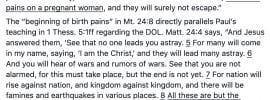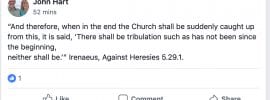Six years ago, I did a six-part series responding to John F. Hart’s (and other pretrib teachers’) unfounded and strained interpretation that the parousia in Matt 24:36–44 is a completely different parousia than the one depicted in Matt 24:27, 30–31. I am re-posting my series below. Pretribs cannot agree with themselves whether Matt 24:36–44 refers […]
John F. Hart
A Response to John Hart’s Flawed Comparison between Jesus and Paul’s Use of the ‘Birth Pangs’ Metaphor
[*There will be no episode of The Biblical Prophecy Program today since I have a respiratory virus and talking causes coughing fits. But in lieu of the program I wanted to write up a reply to the following claim by John Hart.] Source “All these are but the beginning of the birth pains.” […]
Irenaeus Taught that the Church Would Face the Antichrist
Source I want to respond to pretribber John Hart’s misrepresentation of Irenaeus, taking a snippet of Irenaeus out of context and making it sound like he is teaching a pretrib rapture. Nothing could be further from the truth for three contextual reasons. First In Hart’s proof text, I noticed that he conveniently omits the very […]
A Reply to John F. Hart on Why the Parousia in Matt 24:36–44 Refers Back to the Parousia in Matt 24:30–31
Six years ago, I did a six-part series responding to John F. Hart’s (and other pretrib teachers’) unfounded and strained interpretation that the parousia in Matt 24:36–44 is a completely different parousia than the one depicted in Matt 24:27, 30–31. I am re-posting my series below. Incidentally, during these six years I have never received […]
Part 6 – Why the “Coming” in Matthew 24:36–44 Refers Back to Verses 30–31
This is the last installment of our six-part series. The last reason why verses 36–44 refer to the immediate context of the coming in verses 30–31 is found in a helpful parallel passage in the gospel of Luke. The passage in Luke 17:22–37 parallels Matthew 24:23–41. Luke reads: (22) Then he said to the disciples, […]
Part 5 – Why the “Coming” in Matthew 24:36–44 Refers Back to Verses 30–31
The fourth reason why verses 36–44 refer to the immediate context of the coming in verses 30–31 is found in the use of the term parousia. The term is used only four times in the gospels and are all found in Matthew 24:3, 27, 37, 39. Hart argues the parousia mentioned in verses 37 and […]
Part 4 – Why the “Coming” in Matthew 24:36–44 Refers Back to Verses 30–31
The third reason why verses 36–44 refer to the immediate context of the coming in verses 30–31 is recognizing Jesus’ audience. Hart argues verses 4–35 are intended for a Jewish audience and verses 36–44 are for the church. However, both passages have the same audience of disciples. The second person plural “you” is found in […]
Part 3 – Why the “Coming” in Matthew 24:36–44 Refers Back to Verses 30–31
The second reason why verses 36–44 refer to the immediate context of the coming in verses 30–31 is found in the natural antecedent. Verse 36 reads, “But as for that day and hour no one knows it—not even the angels in heaven—except the Father alone” (Matt 24:36). The immediate and natural antecedent of “that” day […]
Part 2 – Why the “Coming” in Matthew 24:36–44 Refers Back to Verses 30–31
As mentioned in the first part, Hart views these two passages as incompatible because he construes verses 4–35 teaching signs before Christ’s coming, while verses 36–44 teaching no signs before his coming. Therefore, he claims verses 36–44 must not be referring back to the coming in verses 30–31, instead must refer to a pretribulational rapture […]
Part 1 – Why the “Coming” in Matthew 24:36–44 Refers Back to Verses 30–31
Pretribs have three big proof texts: James 5:7–9, Titus 2:11–14, and Matthew 24:36. It is the latter proof text that I will split up in a six part series. This first part is the introduction explaining the argumentation for their interpretation. In the next five parts I will give five reasons why the “Coming” in […]



